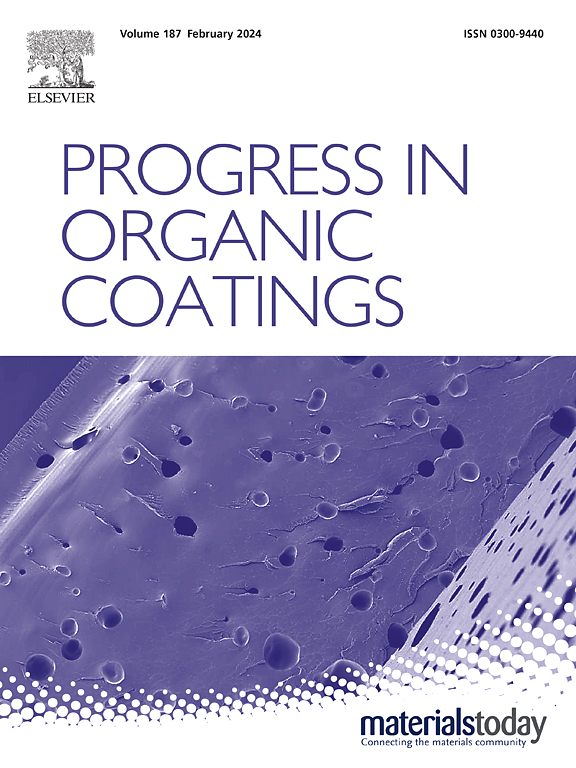磷酸烷基二醇改性氮化硼纳米片增强水性丙烯酸涂料的防腐性能
IF 6.5
2区 材料科学
Q1 CHEMISTRY, APPLIED
引用次数: 0
摘要
氮化硼纳米片(BNNSs)是一种具有特殊阻隔性能的二维(2D)绝缘材料,易发生聚集,这限制了其在防腐涂料中的应用。通过傅里叶变换红外(FTIR)、x射线光电子能谱(XPS)和拉曼光谱分析,证明了磷酸丁二醇乙氧基酸酯(PBEO)是一种容易获得的缓蚀剂,通过π-π相互作用修饰BNNSs。合成的BNNSs@PBEO在水中表现出增强的分散性和与水性丙烯酸乳液的相容性。电化学阻抗谱(EIS)清楚地表明,在3.5 wt% NaCl溶液中浸泡28 d后,含有1 wt% BNNSs@PBEO的丙烯酸涂层在Q235碳钢和5052铝合金上的低频阻抗(|Z|0.01 Hz)分别保持在1010和109 Ω·cm2,比纯水性丙烯酸涂层高约两个数量级。此外,对于Q235碳钢,1 wt% BNNSs@PBEO/丙烯酸复合涂层的水扩散系数比纯水性丙烯酸涂层低3个数量级。这一大幅减少表明涂层的阻隔性能有所改善,这对于实现卓越的耐腐蚀性至关重要。本文章由计算机程序翻译,如有差异,请以英文原文为准。

Enhanced anticorrosive performance of waterborne acrylic coatings doped with phosphated alkynediol modified boron nitride nanosheets
Boron nitride nanosheets (BNNSs), a two-dimensional (2D) insulating material with exceptional barrier properties, are susceptible to aggregation, which restricts their application in anti-corrosive coatings. In this work, phosphate butynediol ethoxylate (PBEO), a readily available corrosion inhibitor, was utilized to modify BNNSs via π-π interaction, as demonstrated by Fourier transform infrared (FTIR), X-ray photoelectron spectroscopy (XPS) and Raman spectra analyses. The synthesized BNNSs@PBEO exhibited enhanced dispersibility in water and improved compatibility with waterborne acrylic latex. Electrochemical impedance spectroscopy (EIS) clearly manifested that the impedance at low frequency (|Z|0.01 Hz) of the acrylic coating containing 1 wt% BNNSs@PBEO remained significantly at 1010 and 109 Ω·cm2 on Q235 carbon steel and 5052 aluminum alloy, respectively, after 28 days of immersion in a 3.5 wt% NaCl solution, which was approximately two orders of magnitude higher than that of the pure waterborne acrylic coating. Furthermore, for Q235 carbon steel, the water diffusion coefficient of the 1 wt% BNNSs@PBEO/acrylic composite coating was three orders of magnitude lower than that of the pure waterborne acrylic coating. This substantial reduction indicates an improvement in the barrier performance of the coating, which is crucial for achieving exceptional corrosion resistance.
求助全文
通过发布文献求助,成功后即可免费获取论文全文。
去求助
来源期刊

Progress in Organic Coatings
工程技术-材料科学:膜
CiteScore
11.40
自引率
15.20%
发文量
577
审稿时长
48 days
期刊介绍:
The aim of this international journal is to analyse and publicise the progress and current state of knowledge in the field of organic coatings and related materials. The Editors and the Editorial Board members will solicit both review and research papers from academic and industrial scientists who are actively engaged in research and development or, in the case of review papers, have extensive experience in the subject to be reviewed. Unsolicited manuscripts will be accepted if they meet the journal''s requirements. The journal publishes papers dealing with such subjects as:
• Chemical, physical and technological properties of organic coatings and related materials
• Problems and methods of preparation, manufacture and application of these materials
• Performance, testing and analysis.
 求助内容:
求助内容: 应助结果提醒方式:
应助结果提醒方式:


